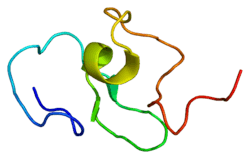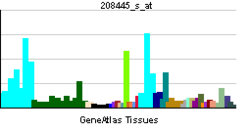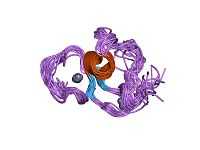BAZ1B
Tyrosine-protein kinase BAZ1B is an enzyme that in humans is encoded by the BAZ1B gene.[1][2][3]
Function
This gene encodes a member of the bromodomain protein family. The bromodomain is a structural motif characteristic of proteins involved in chromatin-dependent regulation of transcription. This gene is deleted in Williams-Beuren syndrome, a developmental disorder caused by deletion of multiple genes at 7q11.23.[3]
Animal models
Model organisms have been used in the study of BAZ1B function. A conditional knockout mouse line, called Baz1btm2a(KOMP)Wtsi,[4] was generated as part of the International Knockout Mouse Consortium program — a high-throughput mutagenesis project to generate and distribute animal models of disease to interested scientists — at the Wellcome Trust Sanger Institute.[5][6][7]
Male and female animals underwent a standardized phenotypic screen to determine the effects of deletion.[7][8][9][10]
| Characteristic | Abnormal |
|---|---|
| Homozygote viability | Yes[11] |
| Body weight | Yes[12] |
| Hair follicle cycling | No |
| Anxiety | No |
| Modified SHIRPA | No |
| Grip strength | No |
| Dysmorphology | No |
| Indirect calorimetry | Yes[13] |
| Glucose tolerance test | No |
| Auditory brainstem response | No |
| DEXA | Yes[14] |
| Radiography | Yes[15] |
| Body temperature | No |
| Eye morphology | No |
| Heart weight | No |
| Heart histology | No |
| Histology | No |
| Clinical chemistry | No |
| Plasma immunoglobulins | No |
| Haematology | No |
| Peripheral blood lymphocytes | No |
| Micronucleus test | No |
| Salmonella infection | Yes[16] |
| Citrobacter infection | No |
| All tests and analysis from [8][9][10] | |
Six significant phenotypes were reported:[10]
- Fewer homozygous mutant mice survived to weaning than expected.
- Mutant mice had decreased body weights compared to wildtype control mice.
- Mutant mice showed increased activity, VO2 and energy expenditure, determined by indirect calorimetry.
- Radiography found teeth abnormalities.
- Dual-energy X-ray absorptiometry (DEXA) showed mutant female mice had a decrease in bone mineral density and content.
- Male heterozygous mice had higher bacterial counts after Salmonella infection.
Interactions
BAZ1B has been shown to interact with:
References
- ↑ Peoples RJ, Cisco MJ, Kaplan P, Francke U (Feb 1999). "Identification of the WBSCR9 gene, encoding a novel transcriptional regulator, in the Williams-Beuren syndrome deletion at 7q11.23". Cytogenet Cell Genet 82 (3–4): 238–46. doi:10.1159/000015110. PMID 9858827.
- ↑ Lu X, Meng X, Morris CA, Keating MT (Jan 1999). "A novel human gene, WSTF, is deleted in Williams syndrome". Genomics 54 (2): 241–9. doi:10.1006/geno.1998.5578. PMID 9828126.
- ↑ 3.0 3.1 "Entrez Gene: BAZ1B bromodomain adjacent to zinc finger domain, 1B".
- ↑ KOMP. "Baz1btm2a(KOMP)Wtsi". www
.knockoutmouse ..org - ↑ Dolgin E (June 2011). "Mouse library set to be knockout". Nature 474 (7351): 262–263. doi:10.1038/474262a. PMID 21677718.
- ↑ Collins FS, Rossant J, Wurst W (January 2007). "A mouse for all reasons". Cell 128 (1): 9–13. doi:10.1016/j.cell.2006.12.018. PMID 17218247.
- ↑ 7.0 7.1 Van der Weyden L, White JK, Adams, DA, Logan DW (June 2011). "The mouse genetics toolkit: revealing function and mechanism". Genome Biology 12 (6): 224. doi:10.1186/gb-2011-12-6-224. PMC 3218837. PMID 21722353.
- ↑ 8.0 8.1 Karp NA, Baker LA, Gerdin AK, Adams NC, Ramírez-Solis R, White JK (2010). "Optimising experimental design for high-throughput phenotyping in mice: a case study". Mamm Genome 21 (9–10): 467–76. doi:10.1007/s00335-010-9279-1. PMC 2974211. PMID 20799038.
- ↑ 9.0 9.1 Gerdin AK (2010). "The Sanger Mouse Genetics Programme: high throughput characterisation of knockout mice". Acta Ophthalmologica 88: 925–7. doi:10.1111/j.1755-3768.2010.4142.x.
- ↑ 10.0 10.1 10.2 Wellcome Trust Sanger Institute. "MGP Phenotyping of Baz1btm2a(KOMP)Wtsi". Mouse Resources Portal. www
.sanger ..ac .uk - ↑ Wellcome Trust Sanger Institute. "Viability at Weaning Data for Baz1b". Mouse Resources Portal. www
.sanger ..ac .uk - ↑ Wellcome Trust Sanger Institute. "Weight Curves Data for Baz1b". Mouse Resources Portal. www
.sanger ..ac .uk - ↑ Wellcome Trust Sanger Institute. "Indirect Calorimetry Data for Baz1b". Mouse Resources Portal. www
.sanger ..ac .uk - ↑ Wellcome Trust Sanger Institute. "Body Composition (DEXA) Data for Baz1b". Mouse Resources Portal. www
.sanger ..ac .uk - ↑ Wellcome Trust Sanger Institute. "X-ray Imaging Data for Baz1b". Mouse Resources Portal. www
.sanger ..ac .uk - ↑ Wellcome Trust Sanger Institute. "Salmonella Challenge Data for Baz1b". Mouse Resources Portal. www
.sanger ..ac .uk - ↑ 17.0 17.1 17.2 17.3 17.4 17.5 17.6 Kitagawa H, Fujiki R, Yoshimura K, Mezaki Y, Uematsu Y, Matsui D, Ogawa S, Unno K, Okubo M, Tokita A, Nakagawa T, Ito T, Ishimi Y, Nagasawa H, Matsumoto T, Yanagisawa J, Kato S (Jun 2003). "The chromatin-remodeling complex WINAC targets a nuclear receptor to promoters and is impaired in Williams syndrome". Cell 113 (7): 905–17. doi:10.1016/S0092-8674(03)00436-7. PMID 12837248.
Further reading
- "Toward a complete human genome sequence". Genome Res. 8 (11): 1097–108. 1999. doi:10.1101/gr.8.11.1097. PMID 9847074.
- Jones MH, Hamana N, Nezu J, Shimane M (2000). "A novel family of bromodomain genes". Genomics 63 (1): 40–5. doi:10.1006/geno.1999.6071. PMID 10662543.
- Pascual J, Martinez-Yamout M, Dyson HJ, Wright PE (2001). "Structure of the PHD zinc finger from human Williams-Beuren syndrome transcription factor". J. Mol. Biol. 304 (5): 723–9. doi:10.1006/jmbi.2000.4308. PMID 11124022.
- Bozhenok L, Wade PA, Varga-Weisz P (2002). "WSTF–ISWI chromatin remodeling complex targets heterochromatic replication foci". EMBO J. 21 (9): 2231–41. doi:10.1093/emboj/21.9.2231. PMC 125993. PMID 11980720.
- Strausberg RL, Feingold EA, Grouse LH et al. (2003). "Generation and initial analysis of more than 15,000 full-length human and mouse cDNA sequences". Proc. Natl. Acad. Sci. U.S.A. 99 (26): 16899–903. doi:10.1073/pnas.242603899. PMC 139241. PMID 12477932.
- Kitagawa H, Fujiki R, Yoshimura K et al. (2003). "The chromatin-remodeling complex WINAC targets a nuclear receptor to promoters and is impaired in Williams syndrome". Cell 113 (7): 905–17. doi:10.1016/S0092-8674(03)00436-7. PMID 12837248.
- Hillier LW, Fulton RS, Fulton LA et al. (2003). "The DNA sequence of human chromosome 7". Nature 424 (6945): 157–64. doi:10.1038/nature01782. PMID 12853948.
- Ota T, Suzuki Y, Nishikawa T et al. (2004). "Complete sequencing and characterization of 21,243 full-length human cDNAs". Nat. Genet. 36 (1): 40–5. doi:10.1038/ng1285. PMID 14702039.
- Beausoleil SA, Jedrychowski M, Schwartz D et al. (2004). "Large-scale characterization of HeLa cell nuclear phosphoproteins". Proc. Natl. Acad. Sci. U.S.A. 101 (33): 12130–5. doi:10.1073/pnas.0404720101. PMC 514446. PMID 15302935.
- Poot RA, Bozhenok L, van den Berg DL et al. (2005). "The Williams syndrome transcription factor interacts with PCNA to target chromatin remodelling by ISWI to replication foci". Nat. Cell Biol. 6 (12): 1236–44. doi:10.1038/ncb1196. PMID 15543136.
- Andersen JS, Lam YW, Leung AK et al. (2005). "Nucleolar proteome dynamics". Nature 433 (7021): 77–83. doi:10.1038/nature03207. PMID 15635413.
- Fujiki R, Kim MS, Sasaki Y et al. (2005). "Ligand-induced transrepression by VDR through association of WSTF with acetylated histones". EMBO J. 24 (22): 3881–94. doi:10.1038/sj.emboj.7600853. PMC 1283952. PMID 16252006.
- Percipalle P, Fomproix N, Cavellán E et al. (2006). "The chromatin remodelling complex WSTF–SNF2h interacts with nuclear myosin 1 and has a role in RNA polymerase I transcription". EMBO Rep. 7 (5): 525–30. doi:10.1038/sj.embor.7400657. PMC 1479564. PMID 16514417.
- Nousiainen M, Silljé HH, Sauer G et al. (2006). "Phosphoproteome analysis of the human mitotic spindle". Proc. Natl. Acad. Sci. U.S.A. 103 (14): 5391–6. doi:10.1073/pnas.0507066103. PMC 1459365. PMID 16565220.
- Cavellán E, Asp P, Percipalle P, Farrants AK (2006). "The WSTF-SNF2h chromatin remodeling complex interacts with several nuclear proteins in transcription". J. Biol. Chem. 281 (24): 16264–71. doi:10.1074/jbc.M600233200. PMID 16603771.
- Olsen JV, Blagoev B, Gnad F et al. (2006). "Global, in vivo, and site-specific phosphorylation dynamics in signaling networks". Cell 127 (3): 635–48. doi:10.1016/j.cell.2006.09.026. PMID 17081983.
External links
- BAZ1B protein, human at the US National Library of Medicine Medical Subject Headings (MeSH)
This article incorporates text from the United States National Library of Medicine, which is in the public domain.
| |||||||||
| ||||||||||||||||||||||||||||||||||||||||||||||||||||||||||||||||||||||||||||||||||||||||||||||||||||||||||||||||||||||||||||||||||||||||||||||||||||||||||||||||||||||||||||||||||||||||||||||||||||||||||||||


